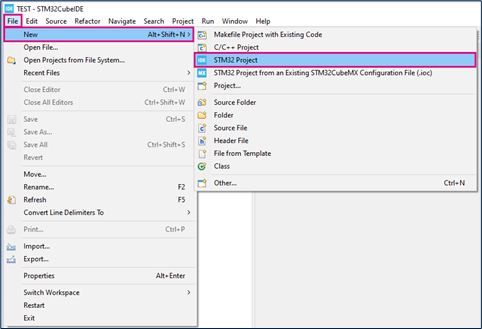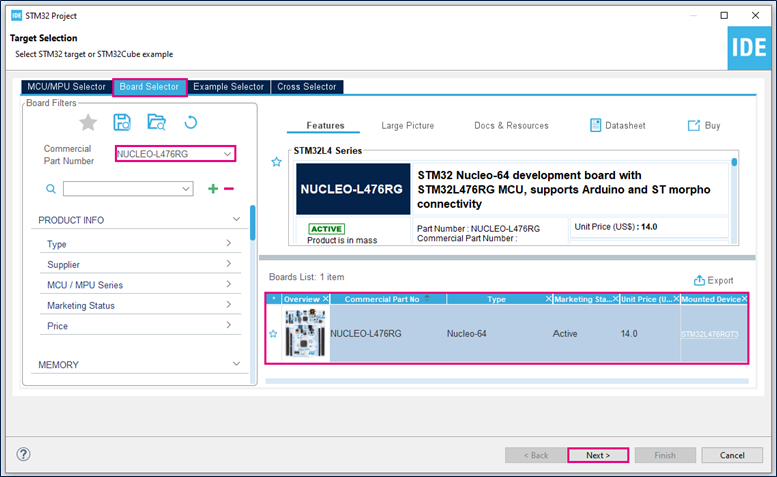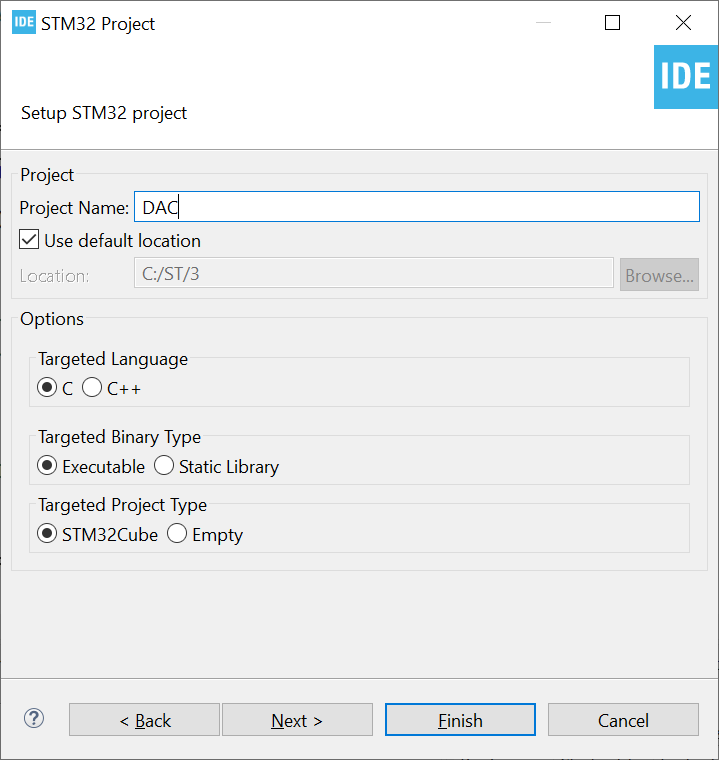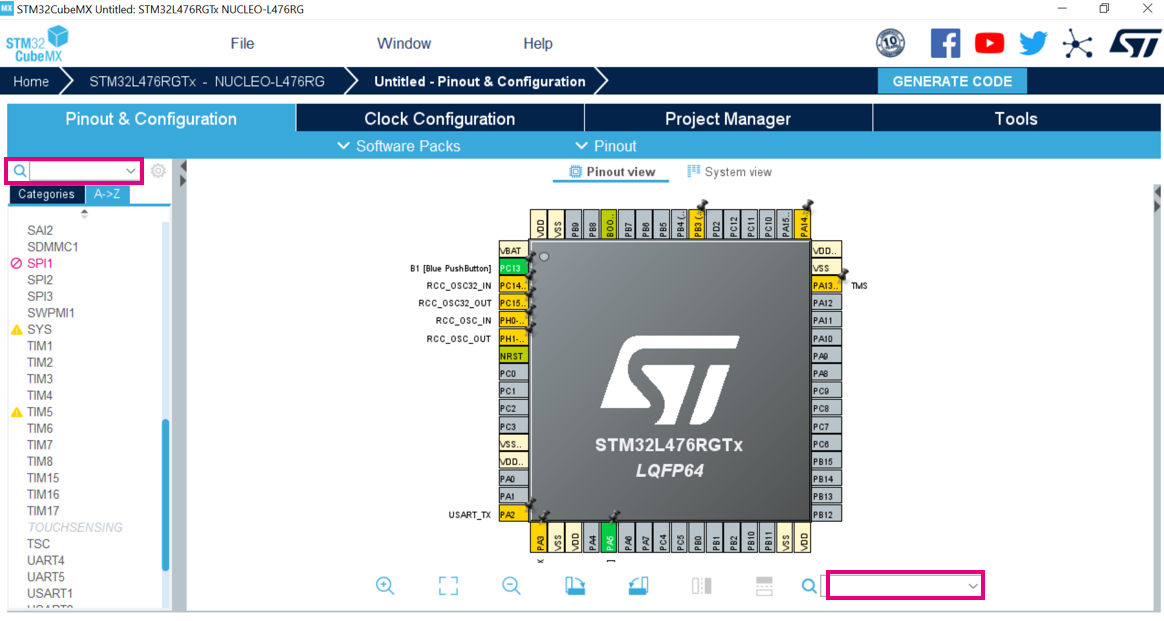| Coming soon |
This article explains how to setup DAC is and how to use it through examples
1. DAC Overview
1.1. What is DAC
A digital to analog converter (DAC) is a device with a function opposite to an analog to digital converter. It takes in a digital number or value as an input and converts it into an analog voltage, the voltage level that corresponds to the binary number in the DAC output register.
To get into DAC, we are going to use STM32L4 DAC module which is a 12-bit word converter, with two output channels.
1.2. Simplified Block Diagram
The DAC output can be buffered for low impedance loads Raw output from R-2R type resistor ladder DAC
When unbuffered, the output is directly connected to the R 2-R resistor ladder network type of DAC.
1.3. DAC with Output buffer
On chip DAC can control the external bias circuitry, replacing potentiometers. The DAC output can have a low impedance buffer to drive external loads, its sample and hold mode can reduce power consumption significantly,
The output data can be transferred by DMA which offloads the CPU. The DAC output data can be updated by a timer or an external trigger as well as a software trigger.
The DAC output can be buffered for low impedance loads Raw output from R-2R type resistor ladder DAC When unbuffered, the output is directly connected to the R 2-R resistor ladder network type of DAC.
1.4. DAC Data Format
The DAC support different input format:
- 8-bit mode:
Right aligned data input (on 16 bit data register)
8-bit + 8-bit data input for Dual channel mode
- 12-bit mode:
Right aligned data input (on 16-bit data register)
Left aligned data input (on 16-bit data register)
1.5. DAC Conversion triggers
DAC output conversion is started by writing to the data hold register (through 6 timer outputs, external I/O trigger, setting the software trigger bit …)
1.6. Sample and Hold feature
This feature is available for extremely low power requirements. DAC can work intermittently, charge the external or internal capacitor. When the DAC is configured in Sample and Hold Mode, it is able to generate its converted output voltage and active circuitry can be turned off.
1.7. Noise and triangle wave generator
The DAC digital interface integrates 2 special signal generators. The Linear feedback shift register can create the noise signal for the DAC input. Each trigger updates the DAC output data by an LSFR block. The Up-down counter with a programmable count value can create triangle wave data which can updates the DAC output data. The data can also be updated by a trigger signal.
1.8. DAC with DMA
DAC can also create DMA requests from the trigger signal. Once the trigger is detected the data hold register value is then transferred to the data output register. Then the DMA request is generated to obtain the new data for the data hold register. As the update of the output data register is initiated directly by the trigger signal. The DAC output signal will not have a jitter, so it can generate a stable sampling time-based output (timer controlled) making it easy to filter out the sampling frequency.
2. Let's get started
2.1. Objective
- Learn how to setup DAC as wave generator in CubeMX
- Generate Code in CubeMX and use HAL functions
- Create simple application to test DAC
2.2. How
- Configure DAC as wave generator in CubeIDE and Generate Code
- Learn how start it in project
2.3. Start a new project
Follow step by step work instructions:
File > New > STM32 Project in main panel.
In this example the NUCLEO-L476RG board is used.
- Select NUCLEO-L476RG in board Selector.
- Save the project.
2.4. Set the project setup for generation
- Search for DAC1 in the left search field
- Search for PA5 then click Reset_State (if already set)
- We will leave the clock configuration as default
- The output buffer is enabled and no trigger is needed.
- If you want to start the project with a board, the LED pin is already selected (PA5 or PA4 on NucleoL476RG. For other boards refer to the user manual), we can measure the output signal on this pin.
Now, generate code.
Updates to perform on main.c are:
/* USER CODE BEGIN PV */
Uint16_t value_dac =0 ;
/* USER CODE END PV */
/* USER CODE BEGIN 2 */
HAL_DAC_Start(&hdac1, DAC_CHANNEL_2);
/* USER CODE END 2 */
/* USER CODE BEGIN 3 */
HAL_DAC_setvalue(&hdac1, DAC_CHANNEL_2, DAC_ALIGN_128_R, value_dac);
If (value_dac<<4095)
{
value_dac++;
}
else
{
value_dac=0;
}
HAL_Delay(1);
}
/* USER CODE END 3 */
- EXPLANATION
Inside the If conditional statement, we will check if the DAC value is lower than 4095 (0xFFF) which is maximum output value for a 12-bit resolution DAC,
If the value is lower than the maximum value, we will increment it.
If not, we will reset it, back to zero,
Then we will add some delay of one millisecond to have a stable output value.
Then run the infinite loop,
So, the code will sweep through all the DAC output possible values, in roughly four seconds and then reset it to zero restarting the process all over again.
3. Test
3.1. Compile and flash
3.2. Build simple signal generator
Connect your multimeter or oscilloscope to the PA5 pin, the DAC output gradually increases up to a maximum output value which is 3V then it will go back to zero forming a sawtooth wave.
3.3. References
Please check these references for further details
AN3126: Audio and waveform generation using the DAC in STM32 products.
Additional info can be found in
AN4566 “Extending the DAC performance of STM32 microcontrollers”. All these documents are available on www.st.com
[[category:Getting_started_with_STM32_system_peripherals | 15]]
</noinclude




